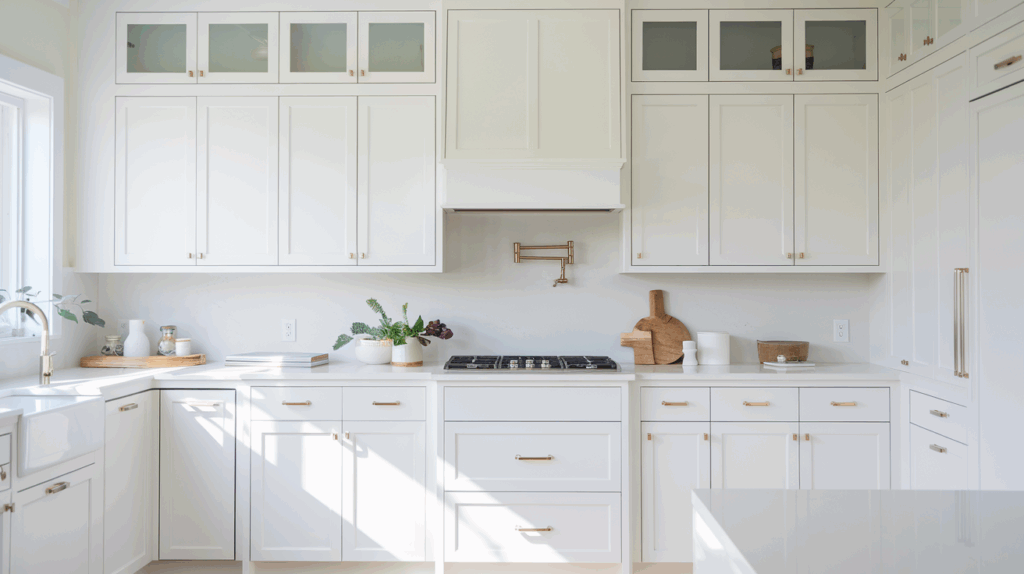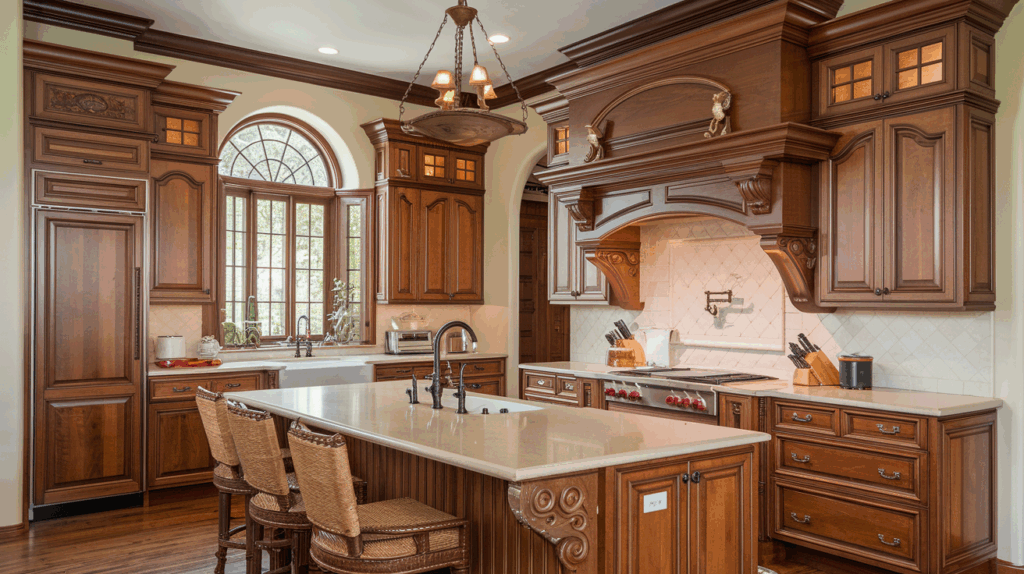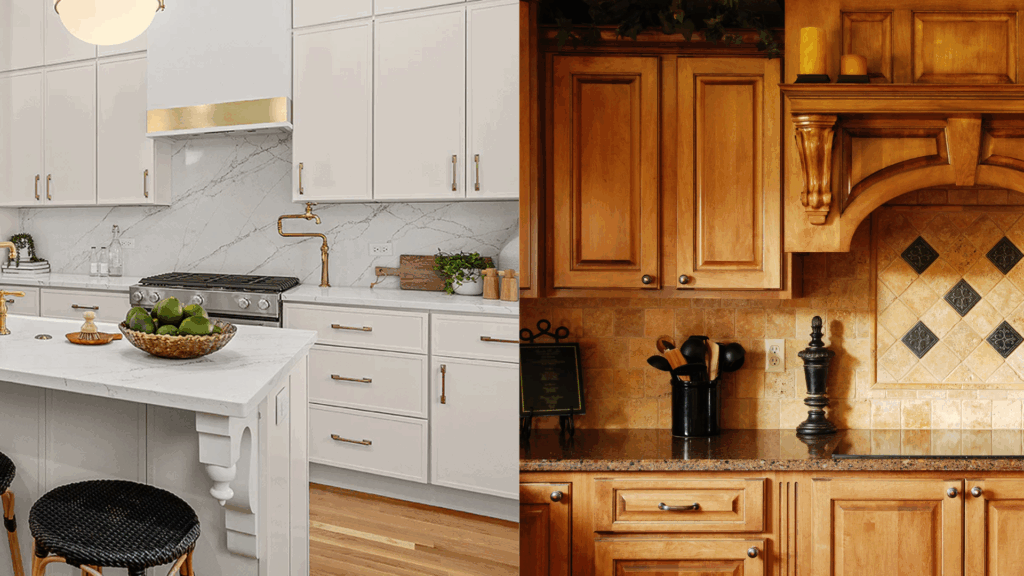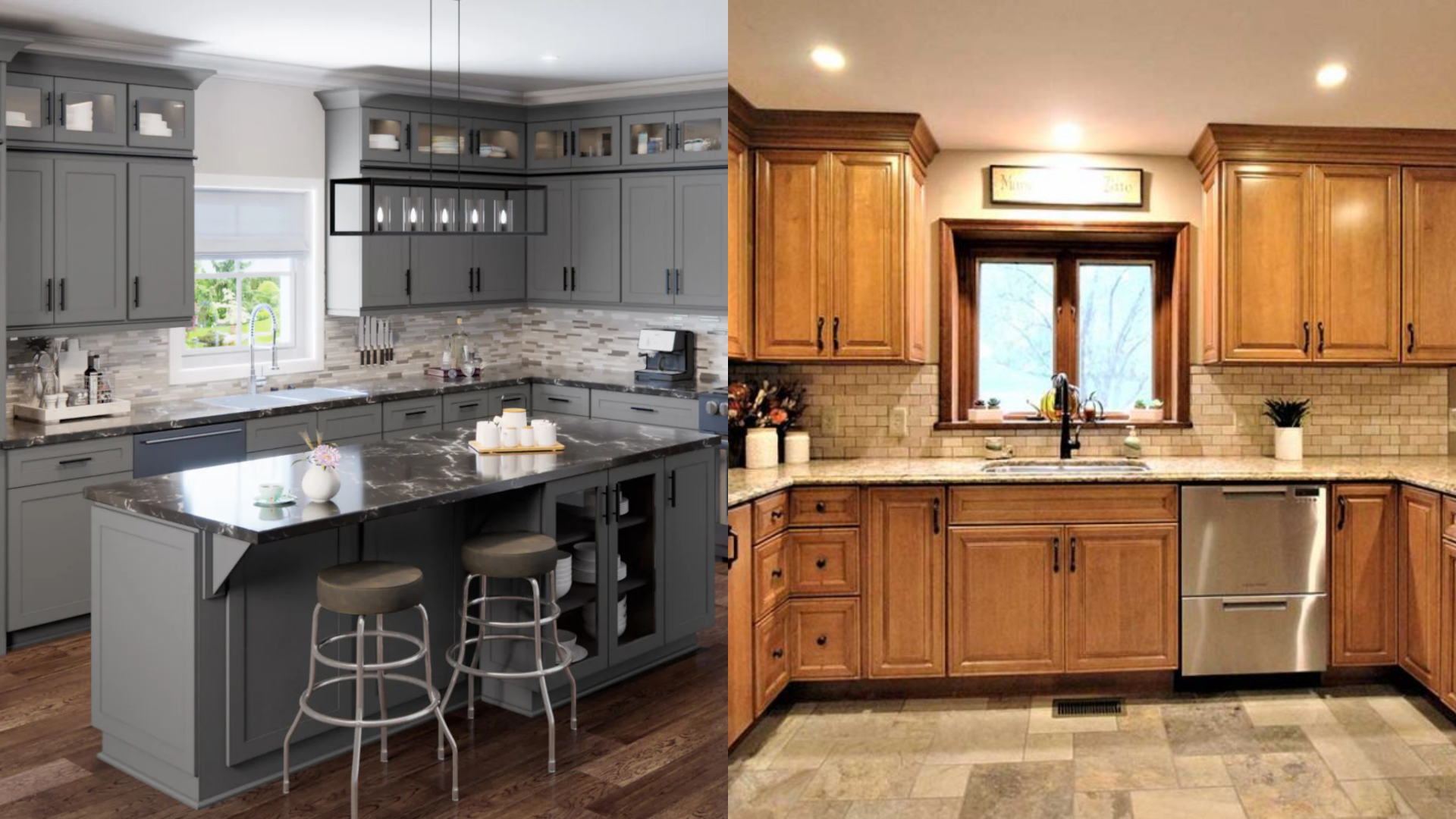I’ve spent time reviewing design blogs, expert opinions, and real kitchen makeovers to compare Shaker and Traditional cabinets. Each has its own appeal.
Shaker cabinets are known for their clean lines and simplicity, while traditional cabinets bring detail and warmth.
Choosing between them isn’t always easy, but knowing how they differ in style, function, cost, and upkeep can make the decision much clearer.
In this post, I’ll break down what defines each cabinet type, where they work best, and what to expect in terms of installation and maintenance.
What Are Shaker Cabinets?

Shaker cabinets are known for their clean, no-fuss design. They feature a five-piece door with a flat center panel and square edges, offering a simple, sturdy look that works in nearly any kitchen.
The style dates back to the Shaker religious community in the 18th century, which valued functionality, durability, and modesty in their furniture.
That spirit lives on in today’s Shaker cabinets; there’s no elaborate trim or carving, just straightforward design that highlights craftsmanship.
Because of their clean lines, Shaker cabinets can lean towards a modern or classic style, depending on the hardware and countertop pairing. Their versatility is what makes them so popular with homeowners and designers.
Pros and Cons of Shaker Cabinets
Shaker cabinets offer a balance of simplicity, versatility, and affordability, but they may not suit every kitchen style.
| Pros | Cons |
|---|---|
| Timeless and versatile design | It may appear too plain for ornate tastes |
| Works in modern, transitional, and farmhouse kitchens | Lacks the decorative detail of traditional cabinets |
| Easier to clean due to flat surfaces | Can show dust on recessed panels |
| More affordable due to simple construction | Limited style variation |
| Wide range of finish options | May need extra hardware for visual interest |
What Are Traditional Cabinets?

Traditional cabinets are all about detail and elegance. Unlike the simple lines of Shaker style, these cabinets feature raised or recessed panels with intricate moldings, curved edges, or decorative arches.
They often include embellishments like corbels, beadboard, or antique-style hardware. The design takes inspiration from European and early American architecture, giving kitchens a more formal and refined look.
Traditional cabinets usually come in rich wood tones like cherry, walnut, or mahogany, though painted finishes like cream or sage are also popular.
These cabinets work well in homes where you want to highlight classic craftsmanship and layered design elements.
Pros and Cons of Traditional Cabinets
Traditional cabinets bring elegance and character, but they require more upkeep and typically cost more.
| Pros | Cons |
|---|---|
| Rich, decorative style adds visual depth | Higher cost due to intricate detailing |
| Timeless appeal in classic or vintage kitchens | Harder to clean due to grooves and moldings |
| Offers a wide range of ornate designs | Can feel heavy or outdated in smaller spaces |
| Pairs well with warm wood tones and glazes | Less suited for modern or minimalist kitchens |
| Customization options enhance uniqueness | More prone to visible wear on detailed finishes |
Key Differences Between Shaker and Traditional Cabinets

Understanding the main differences between Shaker and traditional cabinets helps you decide which style fits your home best. From visuals to maintenance, each choice offers a unique feel and level of upkeep.
1. Design and Aesthetic Differences
Shaker Cabinets: Shaker cabinets focus on simplicity with clean, straight lines and minimal detail, creating a sleek and modern feel.
They’re known for their timeless appeal and work well in contemporary, transitional, or Scandinavian-inspired kitchens.
Traditional Cabinets: Traditional cabinets embrace curves, raised panels, and ornate trims that give off a formal, classic vibe.
They’re ideal for homeowners who prefer a decorative, cozy, and elegant kitchen style with a sense of history.
2. Material and Construction Comparison
Shaker Cabinets: Typically made with solid wood or MDF, Shaker cabinets have straightforward construction with flat recessed panels and minimal adornment.
Their simpler design makes them faster and more affordable to build and install.
Traditional Cabinets: These cabinets also use solid wood or MDF but include additional elements like arches, crown molding, and carved accents.
The more intricate construction increases labor time and adds to the overall cost.
3. Color and Finish Options
Shaker Cabinets: Commonly painted in soft neutrals such as white, gray, or navy, Shaker cabinets fit into a variety of modern and transitional designs.
They’re often finished with matte or satin paint for a clean look.
Traditional Cabinets: Traditional cabinets often showcase natural wood grains or darker finishes with added glazes to enhance depth.
Rich browns, creams, and cherry stains are popular choices, offering a warm and classic tone.
4. Cost Comparison
Shaker Cabinets: With their simpler construction and fewer components, Shaker cabinets are generally more cost-effective.
They’re a great choice for budget-conscious renovations without sacrificing quality or style.
Traditional Cabinets: Due to the detailed work, trim, and specialty features, traditional cabinets usually come at a higher price.
They’re a long-term investment often found in high-end or custom kitchen builds.
5. Maintenance and Durability
Shaker Cabinets: Their flat panels and smooth surfaces make Shaker cabinets very easy to maintain. Wiping down the doors is quick, and there are fewer grooves for grease and dust to collect.
Traditional Cabinets: The decorative grooves and raised panels in traditional cabinets can trap dust and grime, requiring more effort to clean. While still durable, visible wear may show sooner on intricate trim and molding.
6. Upgradability and Kitchen Resale Value
Shaker Cabinets: Shaker cabinets are highly versatile and easy to update with new hardware or paint, which helps them adapt to changing styles.
Their timeless look appeals to a broad range of buyers, often boosting resale value in modern homes.
Traditional Cabinets: Traditional cabinets can also enhance resale in homes with classic interiors, but their ornate style may feel dated to some buyers, making updates more involved and costly
Quick Comparison: Shaker and Traditional Cabinets
This table offers a side-by-side look at the key differences between Shaker and traditional cabinets to simplify your decision.
| Feature | Shaker Cabinets | Traditional Cabinets |
|---|---|---|
| Design | Simple, clean lines | Ornate, detailed moldings |
| Panel Style | Flat recessed panels | Raised or elaborately recessed panels |
| Finish | Matte paints, bold or neutral colors | Rich wood stains, glazes, and warm hues |
| Cost | Generally more affordable | Typically more expensive due to added detailing |
| Ease of Cleaning | Easy to wipe clean | Requires more care due to grooves and trim |
| Best For | Modern, farmhouse, minimalist kitchens | Classic, vintage, or traditional kitchen designs |
How to Choose Based on Kitchen Style
This section helps match cabinet styles to different kitchen themes so your design feels cohesive and well thought out.
- Modern or Minimalist Kitchens: Shaker cabinets offer clean lines and simplicity that match well with contemporary layouts and streamlined appliances.
- Classic or Vintage Kitchens: Traditional cabinets bring ornate details, rich finishes, and a timeless aesthetic ideal for historic or cozy designs.
- Farmhouse or Transitional Kitchens: Shaker cabinets provide a versatile base that works with rustic elements and updated touches alike.
- Formal or Luxury Kitchens: Traditional cabinets elevate the space with crown moldings, glazed finishes, and decorative hardware that reflect high-end taste.
Which One Is Right for You?
Choosing between Shaker and traditional cabinets comes down to your design goals, lifestyle, and long-term plans.
If you like clean lines, minimal upkeep, and a style that fits with both modern and transitional spaces, Shaker cabinets are a great option. They’re budget-friendly, easy to maintain, and widely available.
But if you prefer rich detail, timeless craftsmanship, and a warmer, classic feel, traditional cabinets might suit you better.
They work well in vintage, formal, or European-style kitchens and bring a touch of elegance that feels more decorative. I always recommend thinking about how your kitchen fits with the rest of your home.
Will it be a resale factor? Do you like bold detail or soft simplicity? Answering those questions will help you pick the style that feels right for your space.
Conclusion
Both Shaker and traditional cabinets can transform a kitchen. It really depends on your style and daily needs.
Shaker cabinets are clean, timeless, and low-maintenance, ideal for modern homes or busy households.
Traditional cabinets offer character and warmth, perfect for those who prefer classic elegance.
Consider your budget, maintenance preferences, and the vibe you want for your kitchen. There’s no wrong choice, just the one that fits your space.
Still unsure? Feel free to ask in the comments or reach out, and I’ll help you make the best decision.

